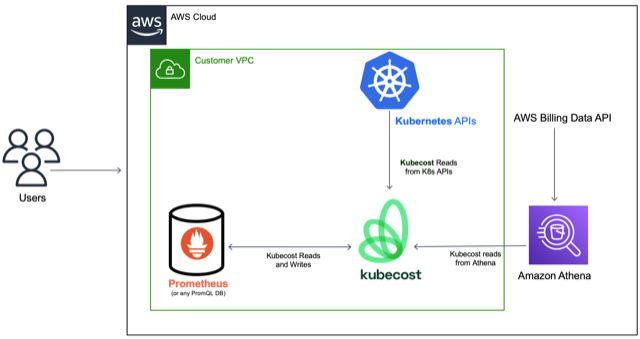
Kubecost is working with AWS to help teams optimize their Kubernetes environments
How it works
Adoption of Kubernetes has grown by 300% since 2016, and more than 70% of the Fortune 100 now use Kubernetes. However, this new ecosystem brings new complexity, especially as teams begin to think about observability and optimization. Kubernetes users are unintentionally overspending and forgetting to clean up resources. Many lack visibility into their costs and usage, which prevent them from having true ownership over their resources.
Kubecost helps customers adopt Amazon EKS and Amazon ECS by giving engineers visibility into spend and resource efficiency in their container environments. Kubecost is also tightly integrated across all Amazon Web Services (AWS). Therefore, customers can join in-cluster costs like CPU and memory with out-of-cluster spend from AWS services for complete cost visibility.

About Kubecost
Kubecost provides real-time cost visibility and insights for teams using Kubernetes. We uncover patterns that create overspending on infrastructure and help teams prioritize where to focus optimization efforts. By identifying root causes for negative patterns, customers using Kubecost save 30-50% or more of their Kubernetes cloud infrastructure costs. Today, Kubecost empowers more than 1,000 teams across companies of all sizes to monitor and reduce costs, while balancing cost, performance, and reliability. Kubecost is tightly integrated with the open source cloud native ecosystem and built for engineers and developers first, making it easy to drive adoption within your organization.
Product features
Cost Allocation
Breakdown costs by any Kubernetes concepts, including deployment, service, namespace label, and more. View costs across multiple clusters in a single view or via a single API endpoint.
Unified Cost Monitoring
Join Kubernetes costs with any external cloud services or infrastructure spend to have a complete picture. External costs can be shared and then attributed to any Kubernetes concept for a comprehensive view of spend.
Optimization Insights
Receive dynamic recommendations for reducing spend without sacrificing performance. Prioritize key infrastructure or application changes for improving resource efficiency and reliability.
Alerts & Governance
Quickly catch cost overruns and infrastructure outage risks before they become a problem with real-time notifications. Preserve engineering workflows by integrating with tools like Microsoft Teams and Slack.